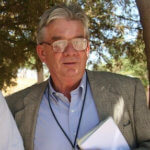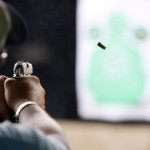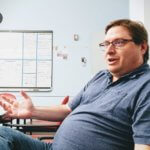Freelance photojournalist Tamir Kalifa spent two days working on this stunning time-lapse video of the Texas Legislature’s opening day for the 83rd legislative session. Lawmakers convene in Austin every two years and the event is widely covered by the media. But Kalifa, an intern at the Texas Tribune, captured the energy of the day in a unique, compelling way. I called him to ask how he did it.
Q: This is actually the second time the Texas Tribune has done a time lapse of the opening day of the Texas Legislature.
A: Yeah, that’s correct.
What were you trying to convey in this particular video and how does time lapse help you do that?
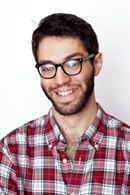
It was amazing. I’m a musician in Austin. Free Week is just coming to a close now. You had all these free shows and everybody is clamoring to get in. It’s one in, one out when it gets to capacity. I realized, as I was desperately trying to get into the House to just get a little glimpse of it, there are a lot of Texans who get that kind of enjoyment and excitement out of the government. And that’s awesome. I really wanted to show that and kind of show the grandeur of it. There aren’t that many things in Texas that are as old as the capital. So it’s also cool to showcase it in that way.
That energy and excitement really comes across in the time lapse. You can really see this frenetic activity.
Frenetic is the word I actually used. It’s so intense when you have so many people. You can zoom all the way out and show it on this huge scale. It’s a way of trying to communicate the complexity of things. It’s the antithesis, in some ways, of what the photojournalist does. I wasn’t capturing moments. It was really kind of a stream of consciousness.
Related: A review of the Sigma 17-70mm lens for videographers
It seems like when you condense everything down like that at a fast pace, you kind of draw out the good parts, like the energy and excitement, and you get rid of the bad parts, like the tedium. I don’t know if opening day was very tedious, but there are a lot of meetings and hearings and lots of waiting at the Capitol.
[pullquote]
So really what I wanted to show was the Legislature sort of waking up and coming to life.[/pullquote]
It’s funny, I actually photographed security and people going up and down the stairs and the hallways. Some of (the shots) weren’t the right length, technically speaking. I didn’t do as quite a good of a job. Otherwise I probably would have included it because I thought those were cool details. But yeah, that’s another huge aspect of it. Another completely different way of looking at something that might seem monotonous and mundane. I would have liked to do things like that. Even people sitting in a room in fast motion, watching people’s body language in hyper speed is fascinating.
I’ve been a big fan of time lapse and how it completely changes your vantage point. A mundane situation suddenly changes into something interesting.
Especially since we’re so familiar with the things around us. As soon as you introduce this variable, all of the sudden it becomes this fresh, wild new experience.
Seems like that could be a real advantage for a story like this. Everybody’s covering the same event, writing news stories about it and taking pictures of it. But something like a time-lapse video gives you an opportunity to tell this story in a different way.
Yeah. If a picture is worth a thousand words, how much are 6,000 pictures put together at 24 frames a second worth? It says a lot. You can describe the amount of people who were there and the energy, but I don’t think anything is able to show that quite like a time lapse.
You mention the 6,000 photos. That was in the description of the video. It says you took 6,000 photos, used two different cameras and a variety of lenses — including a Ukrainian tilt-shift lens. Can you elaborate on the specific cameras and lenses you used?
[pullquote]
If a picture is worth a thousand words, how much are 6,000 pictures put together at 24 frames a second worth?[/pullquote]
Yeah, of course. I”m a photojournalist and my main cameras are a Canon 5D Mark II, and the original 5D, which I guess is now being referred to as the 5D classic. Really, only in the past couple months have I started experimenting with time lapse. I’ve got a variety of lenses that I use for shooting assignments. Mostly primes and a 16-35 zoom. And that’s what’s always able to get the job done.
I had ordered an intervalometer for an assignment I did for the Tribune in September, just documenting the Tribune festival that they put on every year. But I accidentally had it shipped to my parents’ house so I had to go out and buy another one. My parents ended up sending that one back, so, I figured I might as well put one and one together. That ended up being blessing in disguise because I was able to be twice as efficient. I would put the 16-35 zoom on one (camera), then I would put my 70-200 telephoto on another, and basically create a sequence of wide and tight shots and vary that. Or even just have alternate angles, being able to do more with less.
I’ve always been fascinated by tilt shift. It’s another way of looking at the world that is highly unfamiliar to us and novel. It’s gimmicky. But at the same time ….
It produced some pretty striking shots like that opening morning scene at the capital.
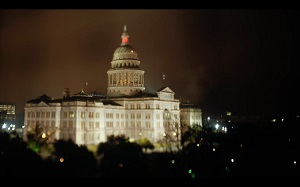 Yeah. What’s really interesting to me about it is the perspective-control aspect of it. That’s why I’m very fond of it. It allowed me to show the majesty of this castle we have in the middle of Austin. It’s cool you can use that technique to create that extremely narrow and sharp point of focus, where everything else becomes so blurry it looks miniature.
Yeah. What’s really interesting to me about it is the perspective-control aspect of it. That’s why I’m very fond of it. It allowed me to show the majesty of this castle we have in the middle of Austin. It’s cool you can use that technique to create that extremely narrow and sharp point of focus, where everything else becomes so blurry it looks miniature.
What specific lens is that? What is a Ukrainian tilt-shift lens?
So I’m actually an intern with the Texas Tribune, I graduated from UT in May. So I was a student on a budget, now I’m an intern on an even tighter budget. I have always tried to come up with solutions by mixing and matching and turning my camera into something of a Frankenstein. I ended up finding this lens made by a company called Arsat. It’s a 35 millimeter f/2.8 tilt-shift lens. It’s totally manual. There’s nothing electronic in the lens, which is why it was $640 or whatever.
Is that on Amazon or something? Where do you find that?
Yeah, Amazon. I looked at the reviews and it was kind of an impulse buy. But I think this will allow me to do things I want to do. Sometimes I feel limited by the format of photojournalism, not because of the medium itself, but because of how inundated we all are with images. Sometimes it takes something striking to make people slow down and look at things.
So you had two cameras. And they’re both Canons, so that’s nice. Do you set the saturation and sharpness and brightness settings to all neutral, and try to match the white balance settings to make sure all the pictures come out with the same look?
[pullquote]
I set the shutter speed to one second, and I used the intervalometer to take a shot every five seconds.[/pullquote]
To a degree. I did try to create a consistence aesthetic. I set the (camera’s) shutter speed to one second, and I used the intervalometer to take a shot every five seconds. Between five seconds and three seconds, depending on how much time I was going to have. When I was in the House, I basically had to fight my way in. They wouldn’t let me use a tripod, so I had to ask somebody if I could borrow their seat for 10 minutes, then I basically put the camera on the chair and put the lens on my wallet so it would get to the right height, and pretty much left it until they dragged me out of there.
As far as the actual workflow goes, I shot in jpeg small. I’ve done time lapse in the past and shot jpeg medium, and it was a little bit difficult to process. You really don’t need that much information in each frame. Because 2K is already a killer resolution. That’s jpeg small. So I shot, you know, several thousand pictures. Then I just dropped each scene into a folder after I imported them, then I dragged them to Lightroom. Adobe Lightroom. What’s special about it is that you can batch-edit images. You can not only control the color, the exposure, hue saturation, everything, you can also crop all the photos.
So that’s very handy.
Yeah. What’s also great is you can use a spot correction tool that will apply to the photos across the board, which is great. So, for example, the last shot, I had to shoot at f/16 in order to have long exposures to make it smoother. Because if you shoot in aperture priority and you have a wide aperture, your shutter speed’s going to go a lot faster. And faster shutter speed makes for a really choppy time lapse. So I try to keep everything no faster than half a second. So that sometimes meant shooting at f/16. And when that happens — I’ve been using these cameras all over the country, all over the world, and they’ve gotten pretty dirty. No matter who cleans it, my sensors are very, very dirty. So at f/16 you can really see that. And what’s great about Lightroom is you can go in, the dust specks aren’t moving, so the program is actually able to correct the spots based in the data around each unique point in that image. So it totally gets rid of them.
You mentioned the shutter speed. I was going to ask about the really nice blurring effect of the people who were walking around. So you achieved that by using a slower shutter speed?
Yeah. And what I also bought was an ND filter so I didn’t have to worry as much about closing down my aperture and I could focus on just getting the proper shutter speed, which is the most important part of the time lapse.
So this is the filter that lets less light in.
Yeah, a neutral-density filter. All it does is it cuts down the amount of light. I had it on for the entire time and it made it so much easier. If I wanted to get a shot of the Capitol during bright sunlight and the clouds are going to be streaking across the sky, the only real way to accomplish that at a slow shutter speed would be with an ND filter.
So at some point after you’re done doing the batch edits, then you have to create the video. Are you using a Mac or a PC?
[pullquote]
It was so incredibly easy to edit. Almost stupidly easy to edit.
[/pullquote]I use a Mac and I edited on Adobe Premiere. Because Premiere just has an incredible work flow for both photo and video. So I broke up all the individual shots in the different folders and I made sure I sequenced them. So for example, “ExteriorCapitolDome_001.” Then I just sequenced it to the last picture. Then when I went into Adobe Premiere, there’s an option to import an image sequence. So as long as the files are named consistently, it will import all of that as a single clip. It was so incredibly easy to edit. Almost stupidly easy to edit.
I think you mentioned you used 24 frames per second?
Yeah. That’s the frame rate for motion pictures, film. That’s what the movie guys do, so why not?
Did you get any weird looks from people while you were shooting?
[pullquote]
There was one time I had to basically guard my camera and make sure nobody knocked it over the rotunda.[/pullquote]
Oh yeah. Everybody thought they were going to get in the way of my picture. And it’s hilarious because we’re journalists, I’m like, ‘Please, ignore me. I swear to God, I want you to be in my picture.’ It’s just kind of funny. I was just surprised none of the state troopers told me to move. It was pretty easy, aside from trying to finagle my way into the House, it was really incredibly easy. And people were totally cooperative. There was one time I had to basically guard my camera and make sure nobody knocked it over the rotunda.
That would have sucked.
Yeah. That would have been real bad. So I just used the good ol’ body shield to take care of that.
What kind of feedback did you get from folks after the video was made?
Some people said, ‘This is the best thing to come out of the Texas Legislature in years.’ So that was kind of a compliment, I guess.
The soundtrack was cool. What kind of process did you go through to find that? Finding the perfect song can sometimes be tedious but rewarding, you know?
That actually might be the funniest part because that’s actually my band.
Oh, really? Well there you go, so you got the copyright to it.
[pullquote]
Some people said, ‘This is the best thing to come out of the Texas Legislature in years.’ So that was kind of a compliment, I guess.[/pullquote]
That’s exactly why I did it. It’s short turn around, you know? I live in Austin, I’m a musician. I play in this incredible band with 20 other people. We’re basically a mini orchestra. I play accordion and piano and a couple of instruments, and we got cellos, violins, bassoon, upright bass, horns, sax, percussion. We’ve got everything. … I’ve always got symphonic music to go with the things that I make. It’s really an incredible, incredible blessing. I wouldn’t do it to get my band’s music out there, because that’s not the purpose of this video. It just so happens to be a convenient and efficient way to use the music.
It can be difficult finding the right song. You have to wade through a lot of Creative Commons tracks on SoundCloud or whatever. It’s hit or miss. When you find the right one it’s great. But just getting there can be quite the journey.
I’ve had to do that so many times, just trying to find the right song. What’s funny though is I basically chopped the song and edited it to fit into the duration of the time lapse, so it’s kind of like I’m destroying the integrity of my own music. But it’s for the greater good.
How long did this project take to work on from conception to final upload up to Vimeo?
[pullquote]
One can decide how they want their time lapse to feel based on the duration of the shutter.[/pullquote]
Well, I basically started … I woke up at 4 a.m. on Tuesday. Basically started shooting around 5:30 because I wanted to get the sunrise behind the clouds, basically just the lights turning on in Austin. And I stopped shooting at five (p.m). And I processed all the images throughout the night. I just kind of threw the images into Lightroom, I cropped them, I did whatever color correction I needed to. Then the next day when I as at the Tribune, I put the images into Premiere and I was ready to spend all night editing it. Then I was just like, ‘Eh, maybe I’ll find a song, see how the song works.’ Then I was like, ‘Eh, I don’t want this to be three minutes, I’ll see if I can tighten this up.’ Then after that it was like, ‘Eh, let’s see what kind of sequence and order I can make.’ Then I was like, ‘Oh man, I’m almost done.’ That was an hour after I picked a song. Part of that is because I’ve been editing since I’ve been 11 years old.
For people who want to try time-lapse projects like this, do you have any tips for them?
Yeah. Intervalometers. That’s No. 1. Intervalometer and a tripod. It doesn’t matter what kind of camera you got.
One can decide how they want their time lapse to feel based on the duration of the shutter. So if one wants it to be extremely intense and choppy and frenetic and you can see the strides of individual people as they’re walking around, then you have a fast shutter speed. That’s a little bit easier to to, especially if you’re shooting in daylight.
But if you want that sort of smooth blurring where it’s really not so much people as it is shapes cascading in and out of the frame, then you use a longer exposure.
Do you think web videos, web-savvy techniques like this, do you think more journalists will be picking up these skills in the future? Is this pretty much a given?
[pullquote]
We’re surrounded by so much of the same. And a lot of that information is valuable and extremely important. But at some point, it can begin to become repetitive to the average viewer.[/pullquote]
Yeah. I mean, I really think that whatever techniques anybody can think of to tell a story are going to be used now, more so than ever. Especially if it’s alternative. Because, like I was saying earlier, we’re surrounded by so much of the same. And a lot of that information is valuable and extremely important. But at some point, it can begin to become repetitive to the average viewer. So, finding alternative ways to communicate and kind of rekindle that reaction is something everybody is figuring out how to do.
I’ve been trying to think about applying (time lapse) to more substantive journalism. This was a cool-looking project. It showed the excitement of the Capitol. But as far as issues go or substantive journalism goes, I don’t think it would rank very high on that scale. But my family is Israeli, and I’ve done a lot of work in Israel, documenting the refugee population that’s migrated from Africa fleeing political oppression and difficult economic circumstances. What I could maybe use time lapse for is to show the part near the central bus station where, you know, between 50 and 100 refugees sleep every single night because they don’t have a place to be. Potentially using time lapse as a way of focusing on the moments between the moments that we sometimes miss when we see documentaries or when we see photos.
So this isn’t just a gimmick. You can use these techniques to tell some really powerful stories.
Yeah. That’s what I’d really like to try to do.
